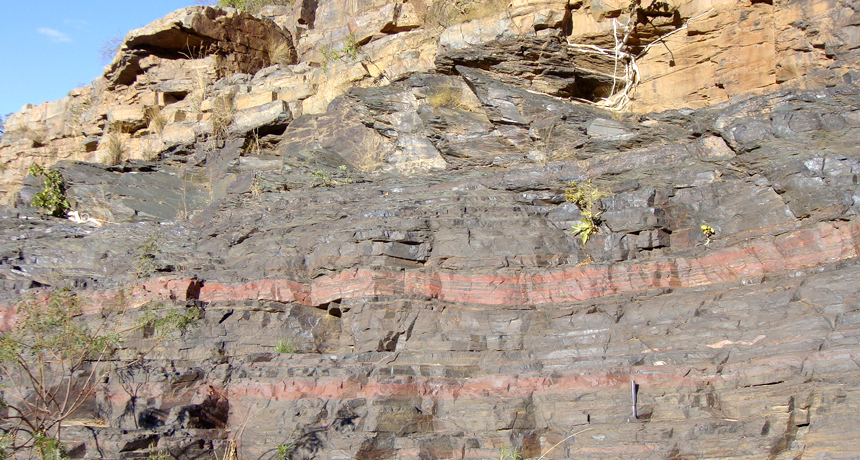
RUSTY BELT Red bands of oxidized iron run through ancient marine rocks in the Pongola river bed in South Africa. Scientists used these and other rocks to determine oxygen was present in Earth’s atmosphere nearly 3 billion years.
Nicolas J. Beukes/Univ. of Johannesburg
- More than 2 years ago
The date of Earth’s first whiff of oxygen may have occurred 300 million to 400 million years earlier than scientists thought. According to an analysis of ancient sediment, hints of oxygen graced the Earth’s atmosphere around 3 billion years ago.
The new date places oxygen on the Earth more than 600 million years before the Great Oxidation Event, when levels of atmospheric oxygen rose dramatically. In the last six years, a handful of geologic studies have dated transient wisps of oxygen to 2.6 billion to 2.7 billion years ago. Scientists think that photosynthetic microorganisms such as cyanobacteria produced the oxygen. So the timing of the first atmospheric oxygen has implications for how photosynthetic life evolved on the planet.
Because photosynthesis is complex, says geologist Sean Crowe who jointly led the study with Lasse Døssing of the University of Southern Denmark in Odense, scientists have thought “that it took a very long time to evolve.” The team’s data, along with the earlier reports that suggest oxygen was present before the Great Oxidation Event, chip away at that notion, says Crowe, who is now at the University of British Columbia in Vancouver.
Crowe’s team made the discovery using 3-billion-year-old rock drilled from 1,000 meters underground in South Africa. Crowe expected the sediments would reveal an oxygen-deprived Earth. Instead, the team found the oldest evidence yet of oxygen on Earth.
The researchers used a highly sensitive technique comparing stable forms of chromium — chromium-52 and chromium-53 — to probe the rock for signs of oxygen exposure. Today, chromium-52 is more abundant in land sediments than chromium-53 is because atmospheric oxygen more readily oxidizes, or strips electrons from, chromium-53. When oxidized, chromium-53 dissolves in water, so rivers carry it to the ocean.
Crowe and colleagues reportin the Sept. 26 Nature that the South African samples had surprisingly low levels of chromium-53, suggesting oxygen was present in the atmosphere at the time. The researchers also detected higher levels of chromium-53 in ancient ocean sediments nearby.
Because the chromium technique has been used only in the last several years, some experts are enthusiastic yet cautious about the findings. “We’re very much in an exploratory phase” in interpreting such results, says geobiologist Woodward Fischer of Caltech.
Geochemist James Farquhar of the University of Maryland in College Park says the team makes “a pretty strong case” that the 3-billion-year-old chromium was oxidized. However, Farquhar says, chemicals other than oxygen may have also played a role in the oxidation.
The results are likely to raise questions about the evolution of photosynthetic life. Scientists think that cyanobacteria, the prime suspects for early oxygen production, evolved 2.7 billion years ago. Other organisms may have produced the earlier oxygen, or cyanobacteria may have evolved earlier than thought.
The research, says biogeologist Roger Buick of the University of Washington in Seattle, “adds greater complexity to our picture of how and when the Earth got its oxygen. It suggests that oxygenic photosynthesis, the ultimate source of most oxygen, evolved long before the Great Oxidation Event.”






